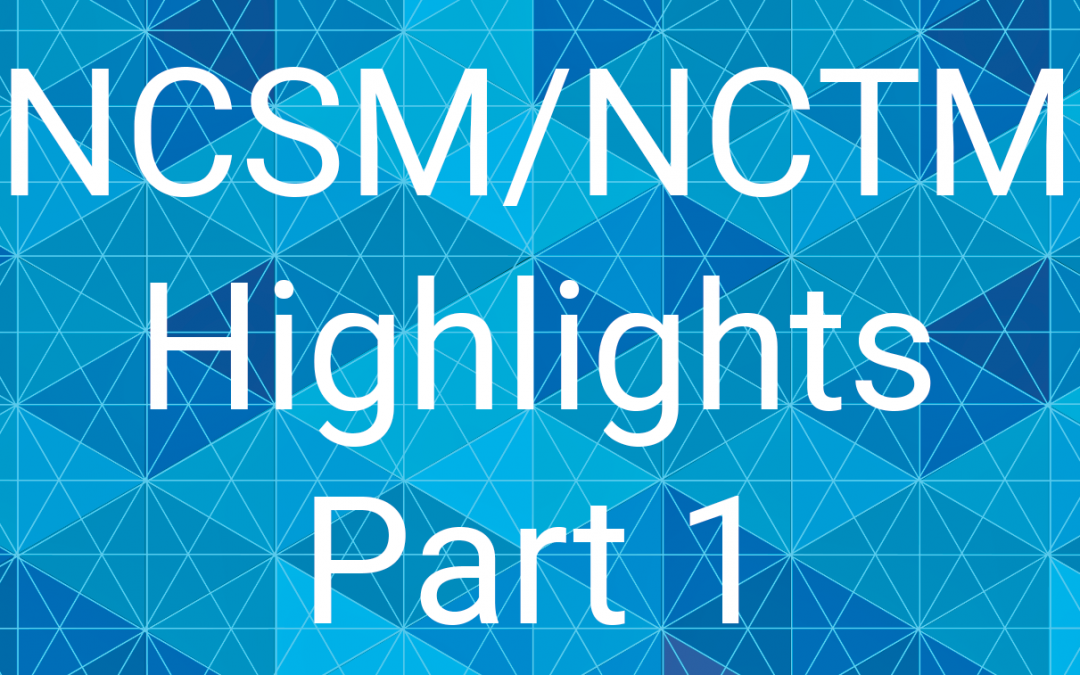Six of our staff traveled to San Diego to attend the NCSM and NCTM conferences at the beginning of April. Below are three staff members’ reflections on a session that stood out to them. Four more to follow next time.
Keith: “From Oakland to Wakanda: Transforming Mathematics Classrooms to Become Empowering Spaces” by Imani Masters Goffney (NCTM)
Imani Masters Goffney gave a fascinating talk about making math classrooms equitable spaces for learning. She used the movie Black Panther as a context to think about mathematics and how it’s taught and learned. She made the point that in Wakanda all the power was in service to humanity and not to power, and that all the citizens of Wakanda had access to that power. She asked us to compare Wakandans—who can travel without assimilating or pretending to be different — to students in our math classes. Who has access? Who has to pretend to be something they’re not?
She made a number of points and observations I continue thinking about:
- “The more math you (the teacher) know, the more math you can see students doing.”
- “Equity is not a destination.”
- Asking students, “Did you see yourself in the math work we did today? Did you get to be yourself today?”
- Learning to “SEE and contribute to the development of the brilliance of black and brown children.”
- Thinking about equity is not about being color blind. In fact, she said, in many classrooms, “using ‘a color blind approach’ means seeing all students as white.”
- Our “big ask” of students every day should always be about the mathematics, and not about behavior or social norms.
- “The work of justice lives in the work of teaching.”
Susan Jo: “Math Strong: Cultivating Equity and Social Justice in Mathematics Education” by Julia Aguirre (NCSM)
Julia Aguirre began her NCSM talk by challenging each of us in the audience to write down our personal “math vision” for what students learn about mathematics and their relationship to it. Then she reviewed some of what is so important about students’ opportunity to learn mathematics: it’s one of the key indicators of general academic success, it’s seen as a proxy for “smartness,” and it is either a gate or a wall in our educational system.
She then asked us to engage in an exercise called “what have you heard?”—a way for all of us to surface the stereotypes that pervade education, explicitly and implicitly: what have you heard, for example, about poor children, about immigrant children, about black boys, about Latinx students, … Phrases that consistently come up as she does this exercise with many different groups include “lazy,” “slow learners,” “not motivated,” “low attention,” “disruptive,” “no support at home.”
As leaders, Aguirre said, we have the responsibility to be change agents, to create a counter-narrative to the achievement gap discourse where these stereotypes reside. “Deficit-based thinking,” she asserted, “is historical, cultural, institutional, ideological, and persistent.” She quoted Geneva Gay (2000): “Culturally responsive teachers have unequivocal faith in the human dignity and intellectual capabilities of their students.”
I find her talks (this is the second one I’ve heard this year) to be challenging to my own practice, especially now that I’m spending time in an urban elementary school that primarily serves children of color. When I articulate a vision for students’ mathematics education, do I talk in generalities? How do I see those general goals become specific and individual for each student? Do I unconsciously hold some of these stereotypes to be true when I’m confronted by students who seem disengaged in math ideas I think are fascinating? Do I have “unequivocal faith” in every student with whom I interact?
Annie: “The Power of Teacher-Led PD in Mathematics” by Michelle Sirois & Heidi Fessenden (NCSM)
How do we make math a more visual, creative, and discussion-oriented subject? This was one of the many thought-provoking questions that Heidi and Michelle—both experienced teachers—posed during their presentation about teacher-led professional development in mathematics.
To explore this question, they displayed the following image and asked us to find the math. One of the things that I loved about this activity was how it managed to be both inviting and challenging at the same time. The image was engaging to look at, and the math wasn’t immediately obvious, which made me eager to hear what others saw.

Heidi and Michelle shared how they used similar activities as part of the math PD sessions that they developed and led in Boston. One of their primary goals was to get teachers who don’t usually choose go to math PD engaged in professional learning that would change their practice. Aside from engaging in math activities in visual ways, the PD focused on building content knowledge, working through student materials, and thinking about how students learn.
Heidi and Michelle explained that effective PD isn’t only about math content or only about teaching strategies, but about the intertwining of the two. Moreover, PD is more effective when teachers have opportunities to work together and learn with and from each other in a supportive environment. The teachers who took part in the PD appreciated that it was led by teachers and located at the Boston Teacher’s Union. This created an environment in which teachers felt more relaxed and less judged. As one teacher commented: “Instead of saying ‘we’re bringing experts in, this person’s going to come and show you this thing,’ and they don’t know nothing about kids… The experts are the teachers.”
This presentation provided a powerful example of what effective and innovative math PD that honors and utilizes the expertise that teachers bring can look like.
- Announcing a New Forum for Equity in Elementary Mathematics - September 13, 2023
- Creating an Equitable Math Learning Community: Getting Started in Unit 1 - August 22, 2022
- A Framework for Reflecting about Equity in the Investigations Mathematics Classroom - September 27, 2021

